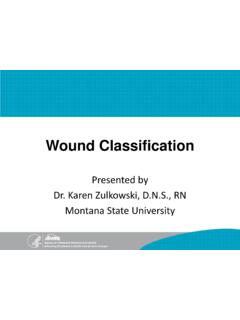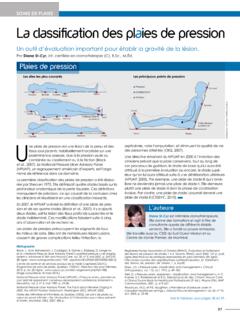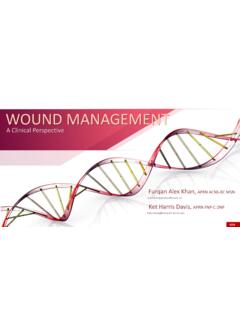Transcription of Apple “PIE” – Pressure Injury Explanation
1 Apple PIE Pressure Injury ExplanationNPUAP 2016 staging SystemClay E. Collins, MSN, APRN, FNP-BC, CWOCN, CFCN, CWS, FACCWSH ealthcare TodayNational Pressure Injury Rates, 2003-2014% of goal to achievehas stalled at Ulcer Prevention SKINS upport surfacesKeep on turningIncontinenceskin careNutritional assessmentSupport SurfacesOverlays and Mattress ReplacementsSupport surfacecheck forobjects inthe bedSupport heels offof the bedLow-Air loss and Alternating AirKeep on TurningPatients are repositioned at least every 2 hours30 degreesKeep HOB no than30-40 degreesKeep 30 degree lateral for side lying positionsKeep using pillows wedges for support Keep turning allpatients every 2 hoursregardless of support surfaceIncontinence/MoistureHigh risk moisture issues are managed appropriatelyMoisturizersprevent or treatthe effects of dry skinProblem areasmay require medicatedointments or powders andare applied by the
2 NurseClear ointments/creams should be used on clearintact skinPaste shouldbe used on irritatedbroken skin & isapplied by the nurseNutritional Assessment Risk assessmentoMini Nutritional Assessment (MNA) Dietary intakeoFood consumption oNeed for assistance Anthropometric parameters Visceral proteinsoSerum Albumin, Pre-Albumin, TransferrinAHRQ, 2008 The npuap ? National Pressure Ulcer Advisory PaneloThe National Pressure Ulcer Advisory Panel ( npuap ) serves as the authoritative voice for improved patient outcomes in Pressure ulcer prevention and treatment through public policy, education and Members:oBoard : 14 MembersoPanel: Collaborating Organization Council Corporate Advisory Council* Provider Organization Council npuap Alumni CouncilWHY? The stages were revised based on questions received by the npuap from clinicians attempting to diagnose and identify the stage of Pressure injuries.
3 To help clarify and hopefully simplify the definitions The rest of the world uses Pressure Injuries , not Ulcers npuap staging system Changes The term Pressure Injury replaces Pressure ulcer Arabic numbers are now used in the names of the stages instead of Roman numerals The term suspected has been removed from the Deep Tissue Injury diagnostic label. Updated staging definitions New definitions, illustrations and photos are available on the npuap website ( ) Pressure Ulcer/ Injury A Pressure Injury is localized damage to the skin and/or underlying soft tissue usually over a bony prominence or related to a medical or other device. The Injury can present as intact skin or an open ulcer and may be painful. The Injury occurs as a result of intense and/or prolonged pressureor Pressure in combination with shear.
4 The tolerance of soft tissue for Pressure and shear may also be affected by microclimate, nutrition, perfusion, co-morbidities and condition of the soft tissue. Because they are not all ulcers To increase awareness putting the Medical device verbage in the definitionInstead of saying not yet elucidated ..they added these conditions into the definitionAdded more description of the Pressure Deep Tissue Pressure Injury (DTPI)Stage 1 Stage 2 UnstageableStage 3 Stage 4 Stage 1 Pressure Injury Intact skin with a localized area of non-blanchable erythema, which may appear differently in darkly pigmented skin. Presence of blanchable erythema or changes in sensation, temperature, or firmness may precede visual changes. Color changes do not include purple or maroon discoloration; these may indicate deep tissue Pressure terminology refers to "erythema", not just "redness Specifically mentions that purple or maroon are NOT Stage 1, they indicate DTPIS tage 1 Think of the normal state of a red delicious Apple .
5 The red color is something that will not go away. We can t touch a red Apple and make the color be less vibrant or make the color go away. A red Apple cant become a green or a yellow Apple . Just like a Stage 1 Pressure Injury , we can t take away the redness simply by touching it. It will not blanch because there are already signs of capillary compromise within the layers of skin. Stage 1 (NOT I)Stage 2 Partial-thickness loss of skin with exposed dermis. The wound bed is viable, pink or red, moist, and may also present as an intact or ruptured serum-filled blister. Adipose (fat) is not visible and deeper tissues are not visible. Granulation tissue, slough and eschar are not present. These injuries commonly result from adverse microclimate and shear in the skin over the pelvis and shear in the heel.
6 This stage should not be used to describe moisture associated skin damage (MASD) including incontinence associated dermatitis (IAD), intertriginous dermatitis (ITD), medical adhesive related skin Injury (MARSI), or traumatic wounds (skin tears, burns, abrasions). The terminology clarifies that a Stage 2 does not have adipose, granulation, slough, or escharIf the cause of the Injury is NOT Pressure don't stage (MASD, IAD, MARSI, and Skin tears)Could be an intact blisterStage 2 Think of an Apple being peeled where you would just want to remove the skin. Just the outside layer, or skin is being removed or impacted when we carefully peel that Apple . The same superficial layer, or epidermis, has been removed or compromised in a Stage 2 Pressure Injury and the wound is only into the dermis or inner most layer, but no deeper.
7 These wounds will not have slough, and they will be superficial in nature. Stage 2 (NOT II)Copyright 2011, Gordian Medical, Inc. dbaAmerican Medical Technologies Key Assessment Criteria Differentiating Stage 2/Partial Thickness Wounds Cannot have or ever have had slough or eschar (necrotic tissue) Heals by regeneration of the dermis and epidermis Heals without granulation tissue Flat edge No undermining or tunnelingStage 3 (NOT III) Full-thickness loss of skin, in which adipose (fat) is visible in the ulcer and granulation tissue and epibole (rolled wound edges) are often present. Slough and/or eschar may be visible. The depth of tissue damage varies by anatomical location; areas of significant adiposity can develop deep wounds. Undermining and tunneling may occur.
8 Fascia, muscle, tendon, ligament, cartilage and/or bone are not exposed. If slough or eschar obscures the extent of tissue loss this is an Unstageable Pressure Injury . Mentions that adipose tissue and granulation are often presentSpecifically calls out the illustration, tooFurther clarification not just bone/tendon Stage 3 Pressure injuries at this stage are full thickness. They involve the underlying adipose tissue. All layers of skin, epidermis and dermis, are gone, so typically the wound has greater depth. Think of what your Apple looks like when you take a nice healthy bite out of and the skin is gone, you are into the juicy meat of the Apple . A Stage 3 Pressure Injury is similar. It now involves adipose tissue and there is usually more depth to these wounds.
9 Stage 3 (NOT III)Stage 3 Stage 3 with EpiboleStage 3 / Full ThicknessStage 4 Full-thickness skin and tissue loss with exposed or directly palpable fascia, muscle, tendon, ligament, cartilage or bone in the ulcer. Slough and/or eschar may be visible. Epibole(rolled edges), undermining and/or tunneling often occur. Depth varies by anatomical location. If slough or eschar obscures the extent of tissue loss this is an Unstageable Pressure Injury . Fascia, muscle, tendon, ligament, cartilage or bone is either exposed or directly palpableThere is no mention of how much slough or eschar has to be in the wound just that it obscures the ability to fully observe the tissueAgain, epibole is mentionedStage 4 These Pressure injuries are also full thickness wounds, but the difference from Stage 3 is that there is underlying structure involved.
10 If you were to bite too far into your Apple , you would get to the to the inner structure of the Apple . This is what happens in a Stage 4 Pressure Injury . You are down to the inner structures under that adipose layer. Stage 4 (NOT IV)What is Epibole? The upper edges of the epidermis roll to envelop the basement membrane or lower edges of the epidermis, so that epithelial migration does not occur at wound edges. (AAWC, 2012)Deep Tissue Pressure Injury Intact or non-intact skin with localized area of persistent non-blanchable deep red, maroon, purple discoloration or epidermal separation revealing a dark wound bed or blood filled blister. Pain and temperature change often precede skin color changes. Discoloration may appear differently in darkly pigmented Injury results from intense and/or prolonged Pressure and shear forces at the bone-muscle wound may evolve rapidly to reveal the actual extent of tissue Injury , or may resolve without tissue loss.


